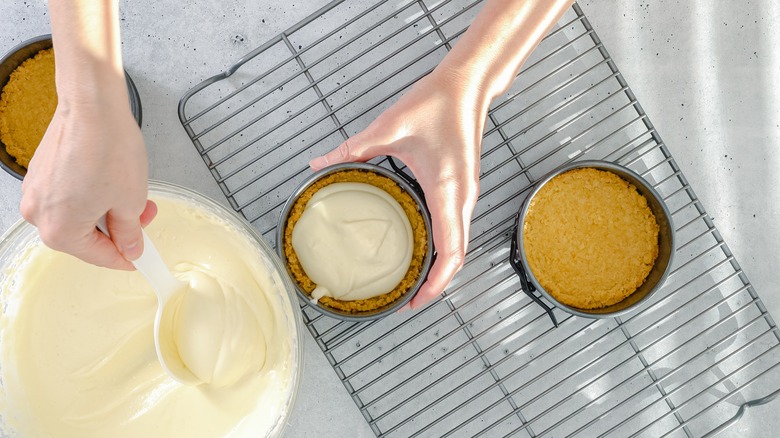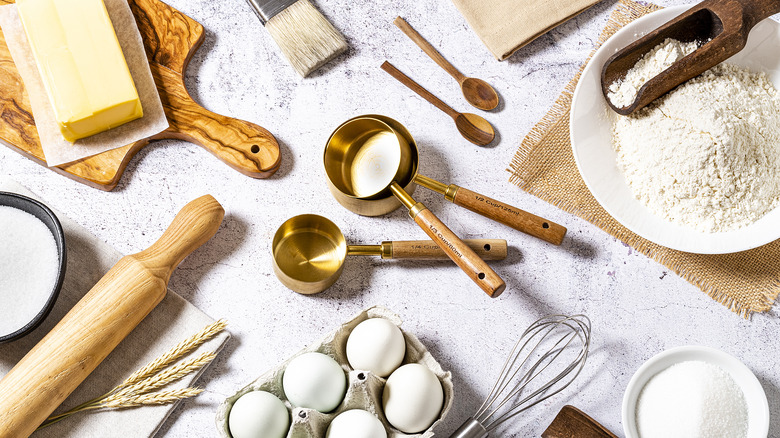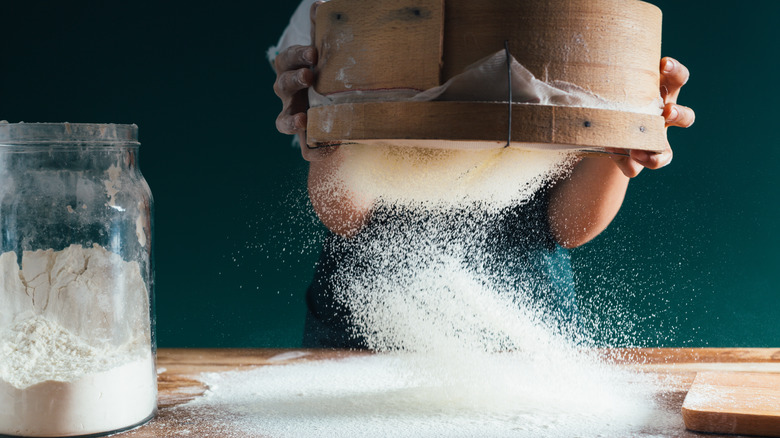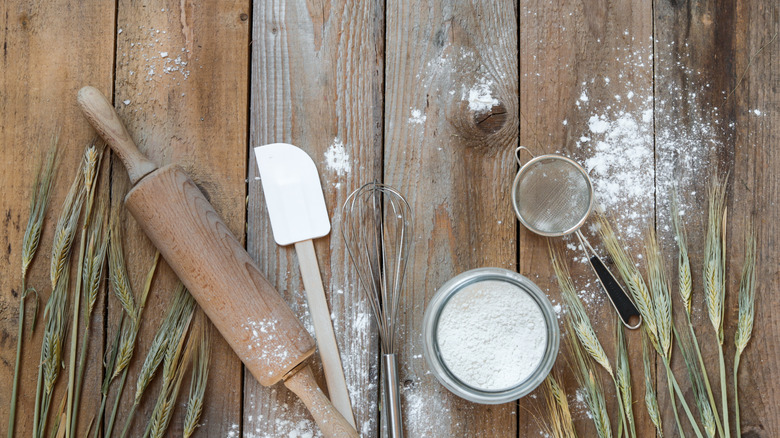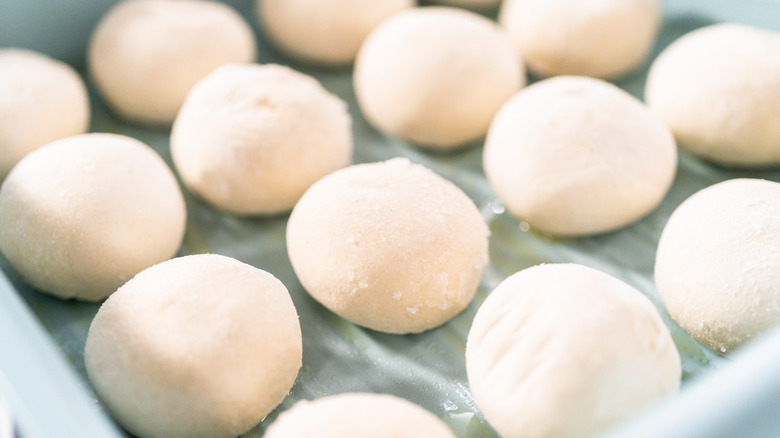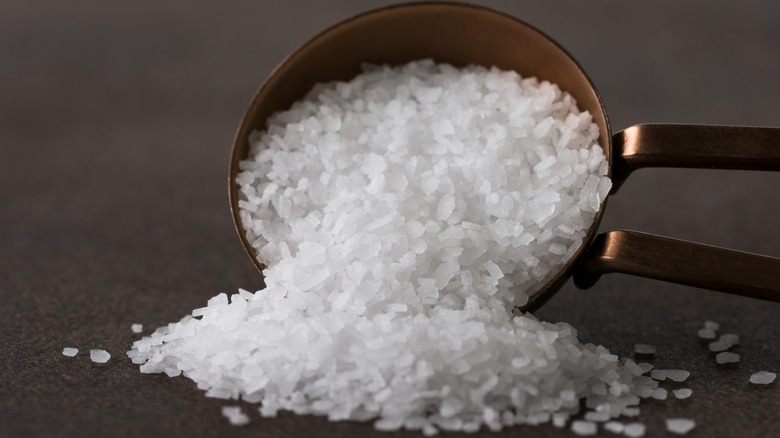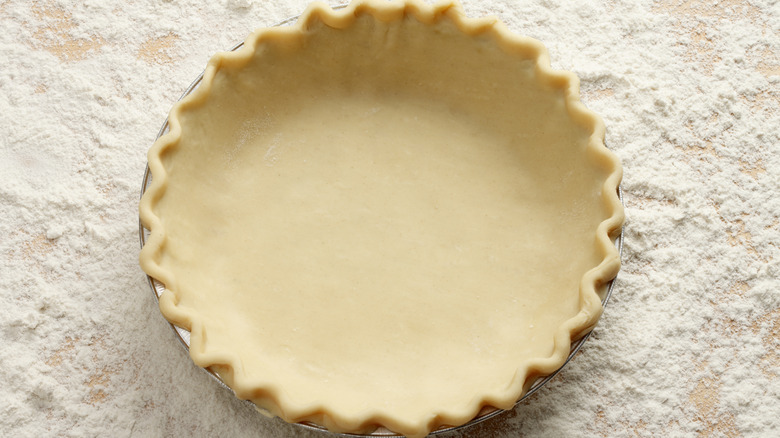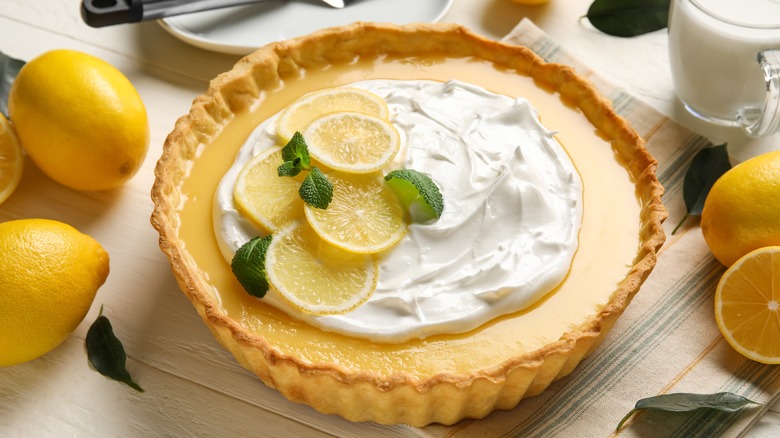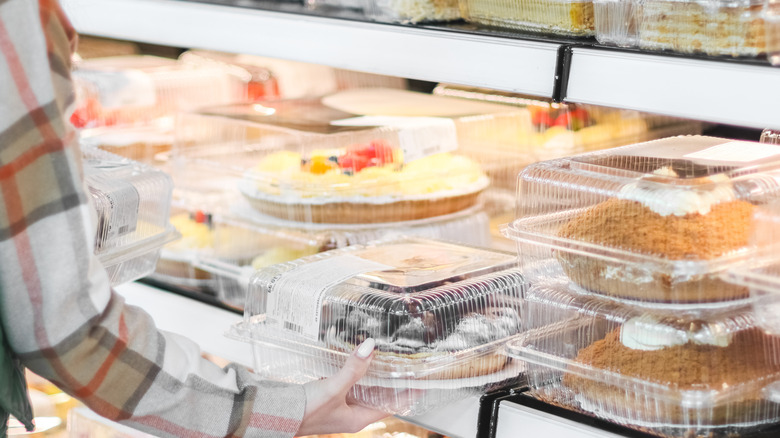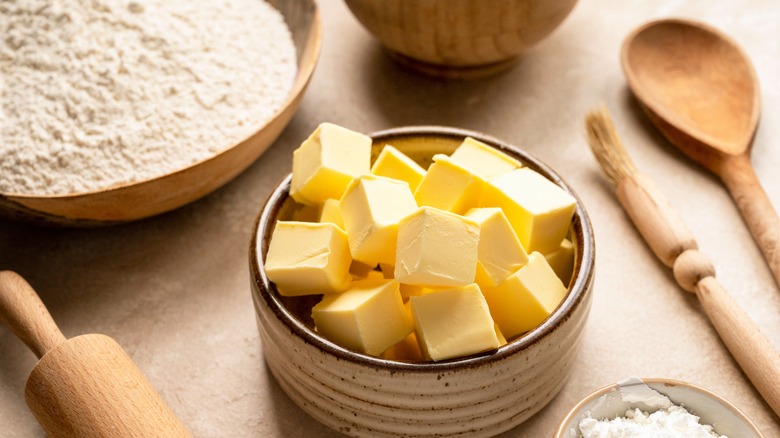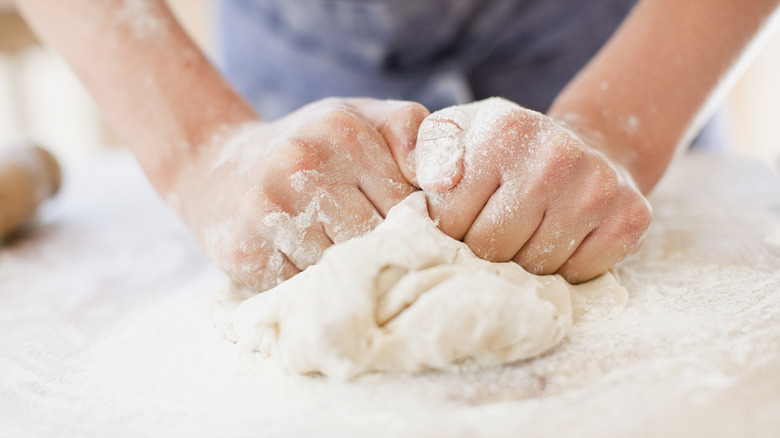Ina Garten's 11 Best Tips For Baking Any Kind Of Pie
Ina Garten's star rose from nuclear energy policy employee under presidents Ford and Carter, to internationally known self-taught food maven and kitchen star, in her hit Food Network show, "The Barefoot Contessa." And, her popularity only grew during the COVID-19 lockdowns after she began posting recipes and tips to her Instagram page for everything from her secret weapon for Macaroni and cheese to French potato salad.
Luckily for all the burgeoning bakers among you, Ina Garten also blessed us with a number of great pie-baking tricks. So, we've collected 11 tips from several media interviews, cookbooks, YouTube videos, and her "Barefoot Contessa" website that will help elevate your pie game even if you're already an expert home baker. Best of all, these tips will not only make both your sweet and savory pies better but will help make your life easier while you do them. Garten has made it known that she's not the fancy chef pulling together elaborate dishes with several hours of prep involved. She even told Food & Wine, "I like to make really simple, absolutely delicious food that takes a couple of hours to make, and I'm not crying and exhausted and sweating." And, when it comes to something as potentially intimidating as baking a pie, the path of least resistance sounds good to us.
Avoid blending your pie crust batter
Unlike other recipes requiring the blending of flour for different sorts of pastries, Ina Garten-level pie crust batter demands a unique method of prepping: Keep your dough buttery and don't mix it (very much). By ensuring there's enough butter dotted throughout the pie batter, you lower the chances of having a dough that's too dry, which will likely result in a pie with the exact same problem.
For a basic flaky, buttery pie crust in under an hour, Garten recommends you use 3 cups of all-purpose flour, one teaspoon of kosher salt, 1 tablespoon of sugar, 12 tablespoons of chilled butter diced into thin cubes, ⅓ of a cup of vegetable shortening, and ½ a cup of ice water. Add your all-purpose flour to a decent food processor, then spoon in your kosher salt and sugar. Blend this powdery mixture together by pulsing on high speed until it's effectively combined. It's at this point where the fat in the form of butter shortening should be added to the mix. Your flour should get to the consistency of pea-sized pebbles before combining the ice water into the mix and blending your ingredients together into a perfect ball of dough. This here is the foundation of a perfect pie crust batter.
Follow baking measurements closely
Unlike more savory comfort foods where the "soul" in soul food has as much to do with intuition as generational knowledge, baking requires adhering closely to the rules. Quoting from her book "Back to Basics: Fabulous Flavor from Simple Ingredients," Ina Garten says, "I think the root of many baking disasters is how you measure the ingredients."
It may come as a surprise to some that Garten never weighs her baking ingredients. She opts for what she knows her fans are most likely to have in their pantries, including measuring cups and spoons. Garten makes this process even clearer by stating, "Always use a liquid measuring cup for wet ingredients — milk, maple syrup, molasses, oil — and dry measures for dry ingredients — flour sugar, cornstarch, and nuts."
However, Garten does admit that weighing ingredients is the most accurate way to measure them. But, if you don't have the benefit of a professional scale as a baking tool, you can still get close enough to a perfect measurement to make a near-perfect pie, using the Ina way.
Sift your flour before taking measurements
As any baking professional will tell you, sifting your flour is as important as any other pre-baking rule necessary to ensure greatness. However, timing is always everything, so when you sift the flour is just as important as the act of sifting itself.
Ina Garten explains that the whole point of sifting flour is to ensure every flour measurement is accurate since clumps that could impact your measurements are sifted out of the equation. As such, she advises the best time to sift your flour is before taking the actual measurements. When you're done sifting, Garten suggests getting your flour into a measuring cup and using a knife to level off the flour.
This is simply the best way to measure flour, and better still, gently patting the measurement cup gets any remaining flour out of the cup with ease. No mess, clogged kitchen sinks, or just white powdery mess, in general, to clean up.
Use proper baking tools
Whether building a house or a pie, assume using the proper tools for the job will be an integral part of your success. It should come as no surprise then that Ina Garten listed her favorite three baking tools in another of her cookbooks, "How Easy is That." She starts off by mentioning French rolling pins because she "can really feel the dough when [she's] rolling it out." This gives the celebrity chef more control over how thin she makes her dough.
Meanwhile, her trio of timers allows her to bake multiple items simultaneously without losing track of time. Finally, Garten recommends having different types of thermometers, including oven thermometers, instant-read thermometers, and candy thermometers, which gives her more control over when to pull things from the oven. So, along with having the appropriate tools in terms of prep and baking, it's equally as important to have tools to tell you when it's time to pull your pie out of the oven. Doing it by eye or feel, just won't cut as baking is a science!
Save your leftover pie dough in the freezer
On the opposite side of the equation, using too much pie dough isn't going to make your pie any better either. Instead of throwing the remainder away, save your leftovers in the freezer. Not only can it be reused for another occasion (or recipe), but you have the added bonus of being ready with pastry dough for dinner parties or impromptu gatherings when you need it.
Ina Garten likes to use her patchwork leftover dough, particularly shortbread, in rectangle cookies, decadently layered with tempered chocolate and capped with roasted pecans. She also makes chocolate-dipped hearts and glazes. So, this trick is perfect for leftover cookies, pizza, and yes, pie dough. Now, you should never find yourself low on dessert options if surprise guests show up for coffee or dinner!
If you're really inspired, you can go ahead and add sugar and whatever other baker spices (think nutmeg, vanilla, or cinnamon) you enjoy. For better cookies, you can even shape them any way you choose and stick them in your freezer for later. Aside from keeping their shape when you finally choose to bake them, they will also taste better since all the flavors you've assembled in the dough have had a chance to come together.
Switch out table salt for Kosher salt
Is every salt built equal? Not where pie is concerned according to Ina Garten. Given that baking is a kind of science, the type of salt you use is also something worth noting. On the "Ask Ina" page of the Barefoot Contessa website, Garten explains that she, "never use[s] table salt because it has a metallic taste and tastes extremely salty. All of [her] recipes are based on Diamond Crystal kosher salt (even using a different brand of kosher salt makes a difference!)."
Although we're talking about pies, salt might be viewed as less of a factor. However, when you consider the number of savory pies that can be made where salt becomes part of the equation, Garten's advice still applies. So, to avoid tin-tasting mince pie, take Garten's advice and stick to kosher salt if possible. It definitely makes tops the list of five types of salt every cook needs to know.
Don't over press pie dough into your baking pan
We've talked about how to manage leftover dough in your freezer for later use. However, if you're thinking about just packing dough, whether fresh or leftover, into your baking pan by pressing it into the base, you probably shouldn't. There's a very good chance your pie dough will bake into your pan, leaving you with an immovable mass of pastry that breaks into pieces when you attempt to lift out the pie. Ina Garten avoids this issue by not overpacking or forcing the dough into the pan.
That said, if you have a little clump of dough leftover that isn't going to make much of a dent in your four-person dessert course, you may want to try and use it (baked-on garnishes spring to mind). Either way, not pressing down on the dough is key to a crust that doesn't get stuck in the dish, and you may also want to think about rubbing your pan with a little extra fat (butter or vegetable oil) as an added insurance policy to keep your pie dough from being too clingy.
Avoid making meringue pie on a rainy day
Who doesn't love the sweet and tangy zing or an incredible lemon meringue pie? But, when it comes to this specific pie or any pies that utilize wispy clouds of sugary meringue, Ina Garten suggests you should never attempt such a pie in rainy weather. In her popular cookbook "Modern Comfort Food", Garten explains that rainy-day moisture can lead to sticky, less adaptable meringues, which is a lot of work for a poor result.
Like most things cooking-related, there's actually a scientific reason for this reaction related to the process of making a meringue. The primary ingredient, egg whites, is inflated by oxygen into the cloudlike substance we know as a meringue through the act of whisking. This basically breaks down the proteins in the egg whites which leads to an airy meringue. When it rains or there is a significant amount of humidity in the air, those egg whites will absorb the moisture, turning that puffy cloud into more of a gooey mess.
Don't be afraid to use store bought pie crusts
You might think that the Barefoot Contessa would frown on anything not made from scratch at home. But, even Ina Garten doesn't want to spend her whole day in a kitchen if she can help it, particularly when it comes to large holiday gatherings. So, in an interview with The New York Times, where she was asked to come up with an entire store-bought version of a holiday dinner, Garten says, "I think just for Thanksgiving, all bets are off. Whatever you need to do to get Thanksgiving dinner on the table is OK."
Garten relied on a store-bought pie crust for an outstanding, classic pecan pie which also benefitted from a decadent bourbon-chocolate pecan filling. As we've learned from previous advice on this list, "chill" dough can be our friend, as long as you allow the crust to properly defrost. If Ina Garten says it's okay to go the store-bought route, then just keep walking on that path of least resistance (especially around holiday time).
Mix cold butter into your dough
It would seem that "cold" is a theme when it comes to perfecting your pie. It stands to reason that if cold dough makes for a more cohesive pie, then the fat you use in the dough should be on the chilled side too. Ina Garten's hack for ensuring butter stays cold while mixing it into the flour is to cube and pre-chill butter in the refrigerator just before blending. Another advantage to this is it allows her extra prep time when making the pie filling, which helps make the process even more efficient. Path of least resistance, remember?
The scientific reason behind the necessity of mixing cold butter into your dough is it keeps the fat content in a relatively solid state (make sure not to over-blend it — Ina recommends 8 to 10 pulses in a blender). You want clumpy butter or shortening because that's what holds the flour together and therefore dictates the outcome of your crust. During the baking process, steam evaporates from the clumps of fat which in turn create the delicate flakiness that all pie crusts crave.
Don't overstretch or overwork your dough
Now you've done all the work of chilling your butter, blending it into your flour, and double-chilling your flour before baking your pie. Before you start working the dough with your rolling pin you should know that overstretching your dough is a horrible idea. In her "Barefoot Contessa Family Style" cookbook, Ina Garten advises against overstretching or working your pie dough as you place it in the pan.
Overworking your dough can lead to your pie crust shrinking while baking, which isn't a great way to keep your pie filling inside your crust. Overstretching, which includes kneading or rolling out your dough, can also lead to a baked pie with a cement-like crust. The reason this happens is simply because the moisture in the mix has been damaged and won't stretch, which leads to dry and brittle dough. This is how you end up with dense and hard pice crust instead of wonderfully flaky, golden brown goodness.


